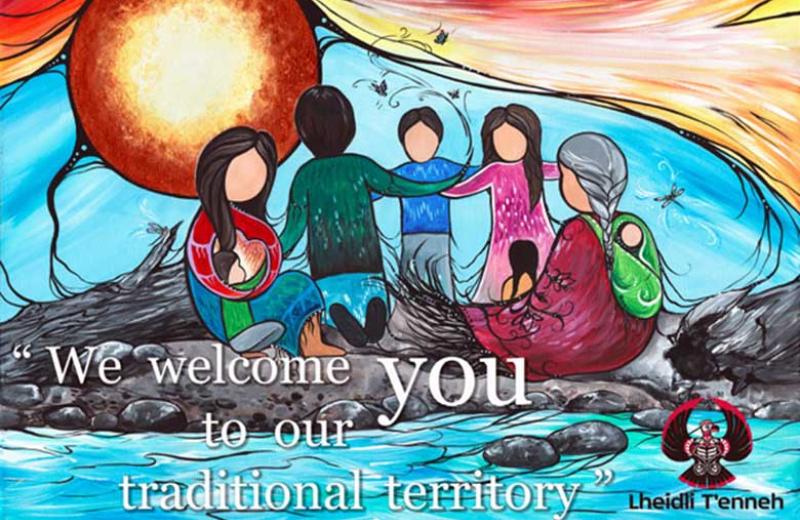The winter of 2018 saw the unveiling of a special work of art that acknowledges the traditional territory of Lheidli T’enneh and welcomes Indigenous and non-Indigenous people to the University Hospital of Northern BC (UHNBC).
The vision for a welcome sign/art installation for UHNBC was born in 2015. UHNBC is located on Indian Reservation #1 (IR#1) and on the territory of the Lheidli T’enneh. So, it was decided that the sign should be an acknowledgement and welcoming to the Lheidli T’enneh territory, and that the sign would be in Carrier (the traditional language of the Lheidli T’enneh).
To begin this project, the PG and Area Aboriginal Health Improvement Committee (AHIC) created a sub-committee to lead and guide the project. With guidance from Lheidli T’enneh chief and council, the sub-committee began planning the steps to create an art installation that would be placed prominently in the hospital.
After a call for Indigenous artists was issued, Carla Joseph, a Métis artist, born in Prince George, with Cree roots in Green Lake, Saskatchewan, was selected to create the sign. Carla created the design with Darlene McIntosh and Mary Gouchie, two Lheidli T’enneh Elders.
“Painting the sign was a great opportunity for me,” says Carla. “I wanted to do a piece that represented community and family. [The people on the sign] have no faces to show that it can be anybody. Making time for each other is so very important. Being an artist, I know art can be healing and inspirational."
The sign is intended to recognize and acknowledge Indigenous peoples in health care facilities and to acknowledge the traditional territory of the Lheidli T’enneh. It’s also an opportunity to offer a learning experience to non-Indigenous peoples entering the hospital.
The welcome sign was officially unveiled on February 23, 2018.
Over a year later, the sign has had a tremendous impact on patients and health care providers alike. Shortly after the unveiling, the PG and Area AHIC voted to purchase additional signs to be distributed in health care facilities across the city.
For patients who access multiple health care facilities in Prince George, the signs acknowledge Lheidli T’enneh territory, provide continuity, and prioritize cultural safety.
Here are some of the locations where you can find a welcome sign, along with community members’ thoughts about the impact they’ve had on each facility:
Positive Living North
“When I go to a location that has one of the welcome signs, I immediately feel more comfortable walking in as a stranger to provide presentations.” – Kyla Turner
BC Cancer Prince George Centre for the North
“The welcome sign helps to set the tone when you walk into the facility and shows that cultural safety is a priority. The sign also provides a sense of continuity of care as BC Cancer Centre is linked to the University Hospital of Northern BC, where the larger presentation of this artwork originates.” – Carolyn Jacob, practice leader, patient and family counselling, and Laura Nordin, Indigenous cancer care counsellor.
Aboriginal Housing Society
“The sign is a symbol of our relationship, acknowledging Lheidli T’enneh traditional territory, and that we are thankful as visitors that we can live in and do our work on Lheidli T’enneh territory.” – Christos Vardacostas
Prince George Native Friendship Centre
“This sign is very meaningful to us, as it represents our working relationship with Lheidli T’enneh, which, for me, has been fostered by being part of the AHIC.” – Erin Anderini
PG Divisions of Family Practice & Blue Pine Primary Health Care Clinic
"We have had many comments on how beautiful the 'Welcome' picture is. When I think of the meaning it brings to our clinic, the theme of beauty comes to mind. We are fortunate to walk on the land of the Lheidli T’enneh. The welcome is a reminder to be mindful and respectful of the people and land of this territory." – Submitted as a group quote.
Foundry Prince George
"The sign speaks to the importance of holding, in the work that we do, the history of this community and honoring territory. It brings forward agendas that bring healing. There is also a continuity from the bigger sign in the hospital – and people recognize that." – Toni Carlton














Comments